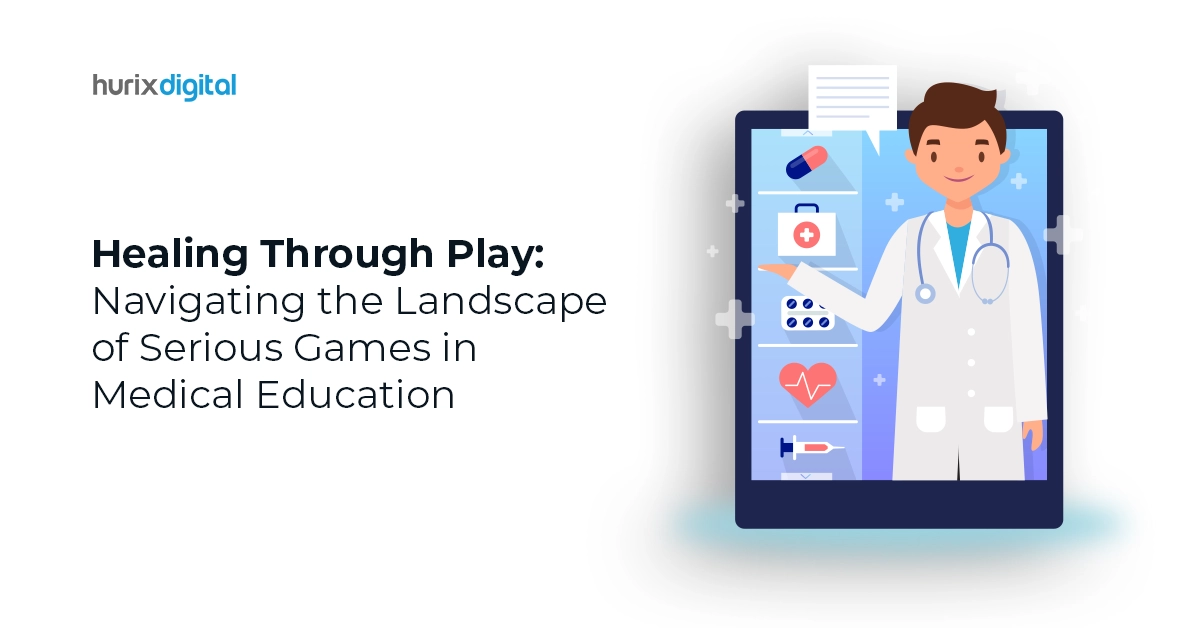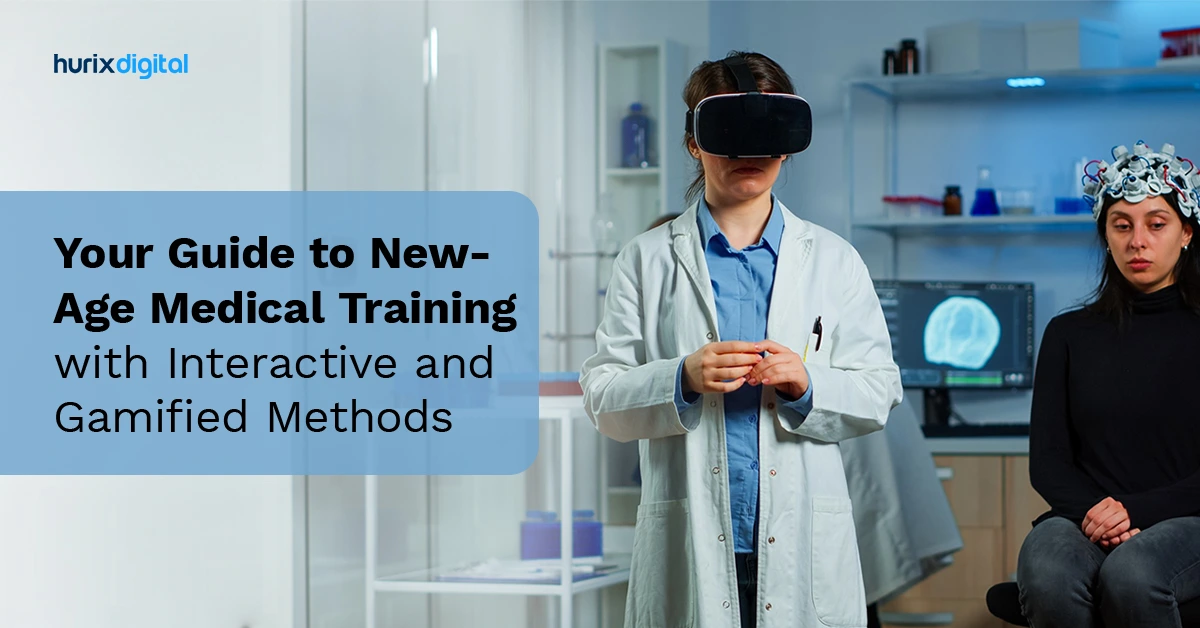
Nitin Sharma
February 18, 2025
Your Guide to New-Age Medical Training with Interactive and Gamified Methods
Summary
This blog explores gamification in medical education, focusing on VR surgery simulations and interactive methods that revolutionize surgical training, enhancing anatomy education and patient safety training.
Table of Contents:
- Components of VR Surgery Simulations
- Advantages of VR in Surgical Education
- Strategies for Successful Implementation of VR
- Future Directions and Innovations in VR Surgical Training
- How is Gamification Transforming Anatomy Education?
- How is Gamification In Medical Education Redefining Anatomy Pedagogy?
- How Does Gamification in Medical Education Make Patient Safety Training More Effective?
- Use Cases of Game-Based Interactive Scenarios
- Final Words
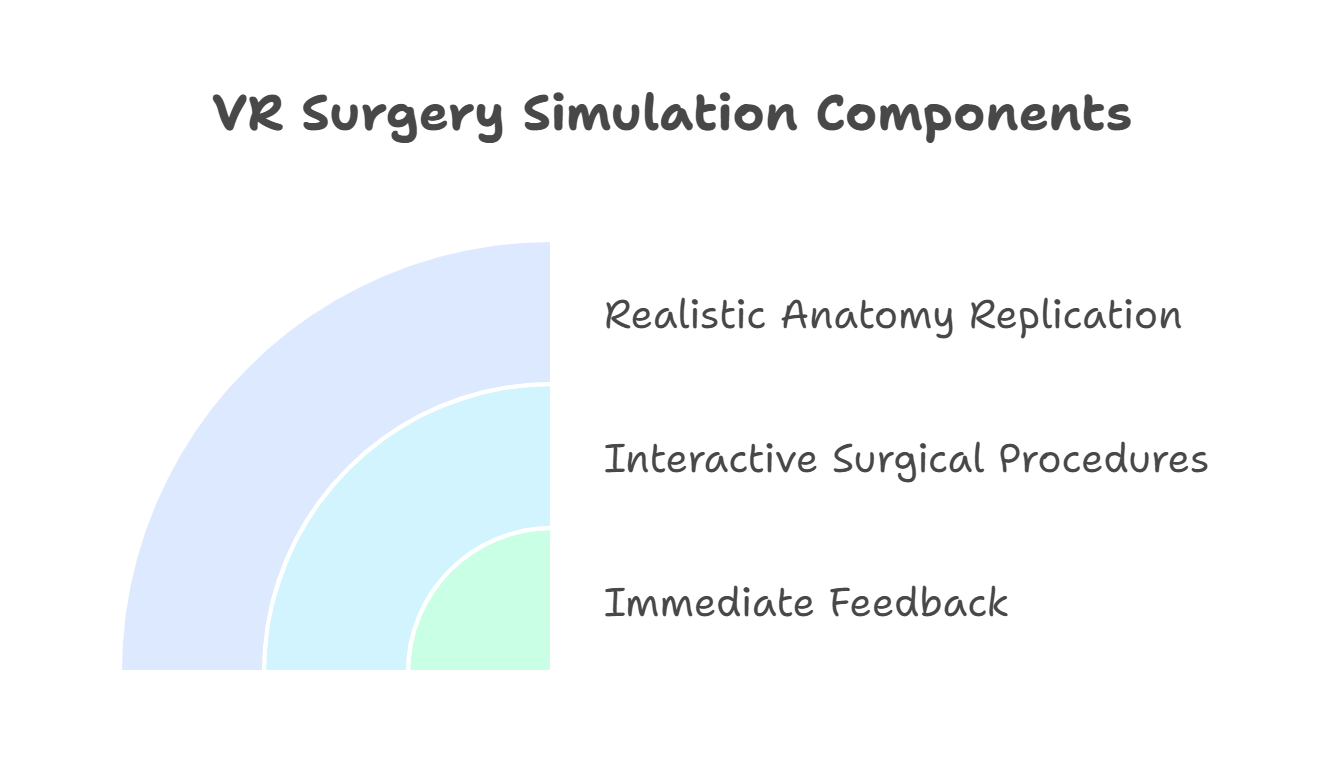
Components of VR Surgery Simulations
Here are the major components of VR Surgery Simulations:1. Realistic Anatomy Replication
Virtual reality surgery simulations replicate human anatomy with precision, allowing surgeons to practice procedures on virtual patients. This realistic representation helps surgeons understand the intricacies of the human body, improving their skills and knowledge.2. Interactive Surgical Procedures
Through VR technology, surgeons can actively participate in simulated surgeries, performing tasks and making decisions as they would in a real operating room. This interactive approach enhances the hands-on learning experience.3. Immediate Feedback
VR in medical education offers instant feedback on surgeons’ performance, allowing them to assess their skills in real-time. This immediate feedback enables continuous improvement, as surgeons can identify areas for enhancement and refine their techniques efficiently.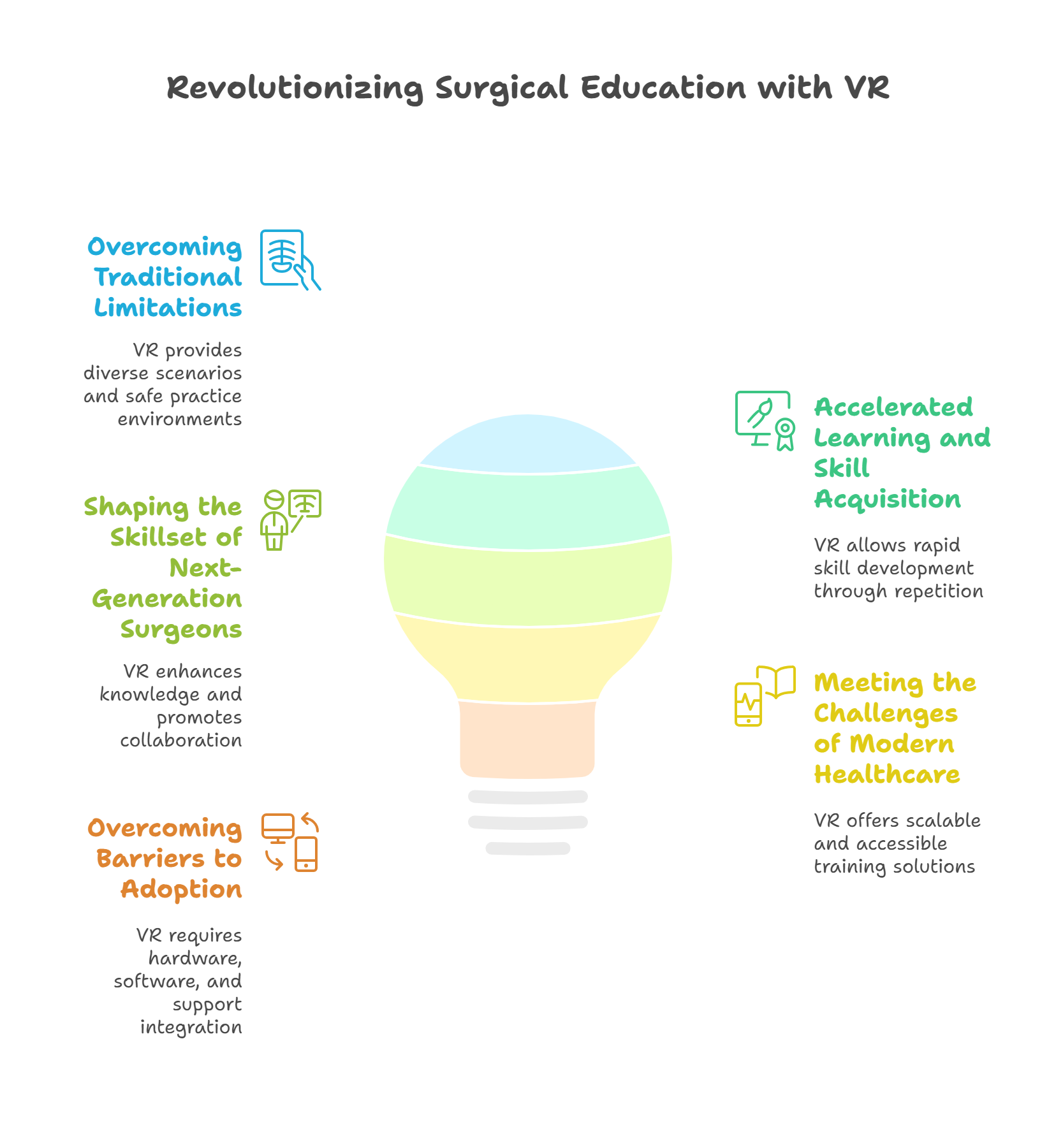
Advantages of VR in Surgical Education
Next-generation surgeon training is revolutionized by the immersive and interactive nature of VR simulations. Here are the major advantages:1. Overcoming Traditional Limitations
VR offers access to diverse surgical scenarios, preparing trainees for real-world challenges they may not encounter during traditional training. Also, it offers a safe environment for making mistakes and learning from them without serious consequences.2. Accelerated Learning and Skill Acquisition
With case-based learning and practice in virtual environments, trainees can accelerate their learning and skill acquisition. They can repeat procedures multiple times, refining their techniques and gaining confidence in their abilities more quickly than with traditional methods. This accelerated learning can lead to more competent surgeons in a shorter amount of time.3. Shaping the Skillset of Next-Generation Surgeons
Virtual reality in healthcare training provides a platform for aspiring surgeons to enhance their knowledge and expertise in a realistic and risk-free environment. It promotes collaboration and knowledge sharing among surgeons, creating a supportive community where experiences and insights can be exchanged.4. Meeting the Challenges of Modern Healthcare
VR in medical education offers a scalable and accessible platform for training, helping to bridge the gap between demand and supply in the healthcare industry. By offering high-quality training experiences, VR technology breaks down geographical barriers, allowing aspiring surgeons from around the world to access standardized and top-tier training programs.5. Overcoming Barriers to Adoption
Ensuring access to suitable hardware, software, and technical support is crucial for the seamless integration of VR in medical education into educational programs. Aligning VR experiences with traditional teaching methods and learning objectives enhances the educational value and relevance of virtual reality surgery simulations.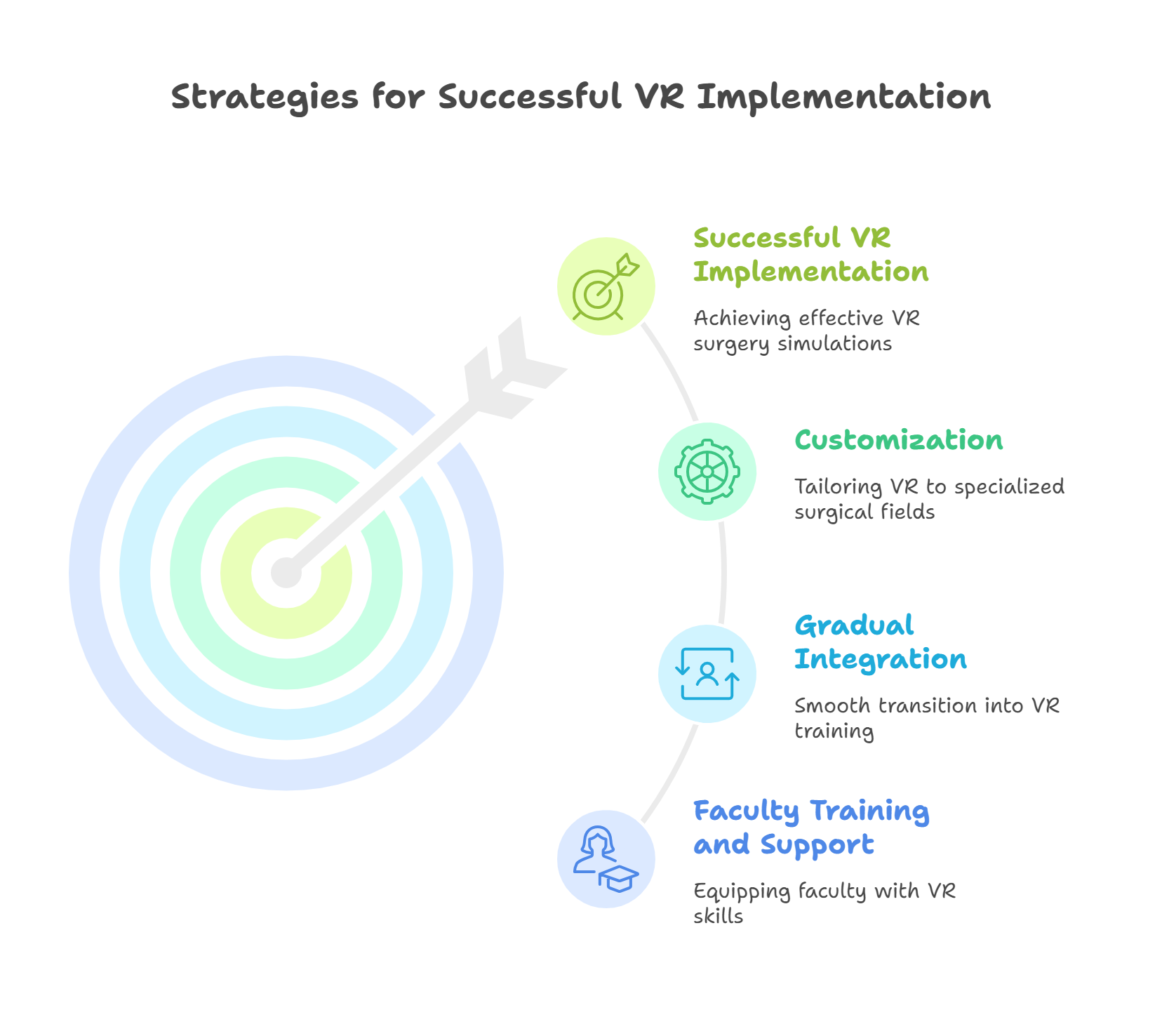
Strategies for Successful Implementation of VR
Below are the top strategies you can follow to ensure successful implementation of VR surgery simulations:1. Faculty Training and Support
Providing faculty members with adequate training and support in utilizing VR technology is essential for effectively incorporating immersive surgical training into their teaching methodologies.2. Gradual Integration
The incremental incorporation of virtual reality surgery simulations into training programs allows for a smooth transition and adaptation to this innovative technology. This will help students and faculty members become familiar with the VR environment comfortably, minimizing overwhelm and maximizing learning outcomes.3. Customizing VR Simulations to Specialized Surgical Fields
Tailoring VR experiences to specialized surgical fields allows for targeted training that addresses each discipline’s unique challenges and procedures. This customization enhances the relevance and effectiveness of virtual reality surgery simulations, ensuring that trainees receive specialized training tailored to their future practice areas.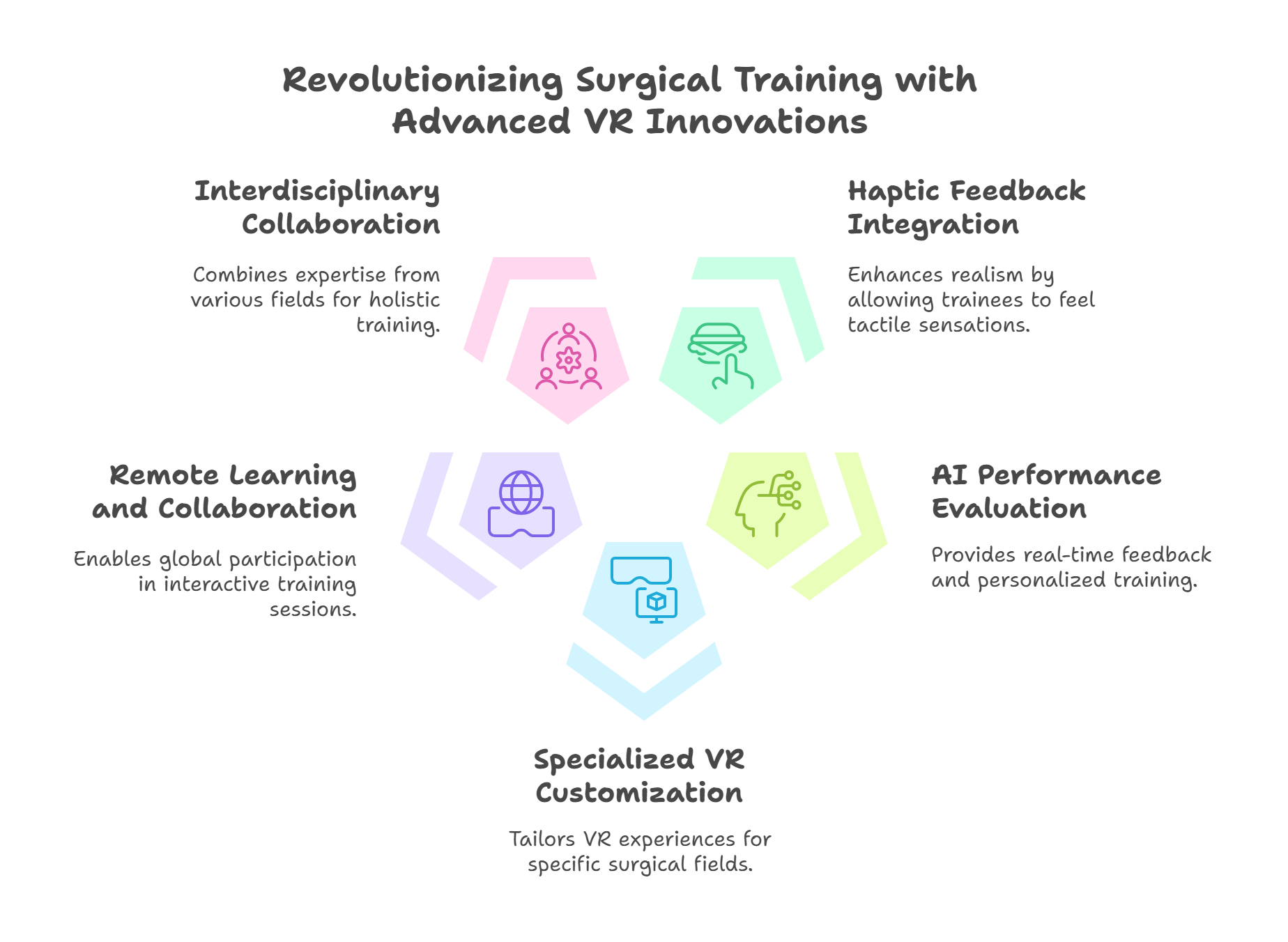
Future Directions and Innovations in VR Surgical Training
The future of virtual reality surgery simulations holds exciting possibilities for further advancements in simulation technology. Here’s what the future holds:1. Pushing the Boundaries of Simulation Technology
Here’s how the future of virtual reality surgery simulations holds exciting possibilities for further advancements in simulation technology:- Haptic Feedback Integration: Allowing trainees to feel realistic tactile sensations during simulations enhances the immersive experience and improves muscle memory.
- Artificial Intelligence in Performance Evaluation: Integrating AI for performance evaluation can provide real-time feedback, track progress, and personalize training, making the learning process more efficient and effective.
2. Customizing VR Simulations to Specialized Surgical Fields
Tailored VR experiences for these specialized fields allow trainees to practice intricate procedures specific to each field, enhancing their skills and confidence in a risk-free environment. Additionally, integrating VR technology into surgical training programs opens avenues for remote learning and collaboration, enabling trainees from across the globe to participate in interactive sessions and learn from experts without geographical constraints. Moreover, advancements in VR hardware and software will likely lead to more affordable and accessible training solutions, democratizing access to high-quality surgical education worldwide.3. Collaboration Across Disciplines For Holistic Training Solutions
Bringing together experts from various fields, such as technology, medicine, and education, to develop comprehensive training programs. This interdisciplinary approach ensures trainees receive a well-rounded education that prepares them for the diverse demands of surgical practice.How is Gamification Transforming Anatomy Education?
Procuring human cadavers is a complicated process. It involves lengthy legal and ethical nuances. Additionally, the process of transporting, preserving, storing, and safe disposal only adds to the expenses. Similarly, with a large number of students, getting a close look at cadavers can be a challenge. Coupled with growing expectations and changing healthcare education dynamics, many favor gamification in education as an alternative learning method. Unlike rote memorization, gamification in anatomy education leads to better learning retention. Studies have shown that gamified medical education creates intriguing learning experiences and helps students elevate their clinical skills. Another major benefit of integrating games into medical education is easy accessibility. This is where gamified anatomy education revolutionizes traditional methods. With the help of gamified anatomy education, the constraints and challenges associated with traditional methods are effectively addressed, leading to a transformative shift in medical education. Besides, unlike physical labs, gamified materials aren’t bound by any operating hours. Learners (and educators) have the flexibility to carry out their tasks, even if they have tight schedules and night shifts.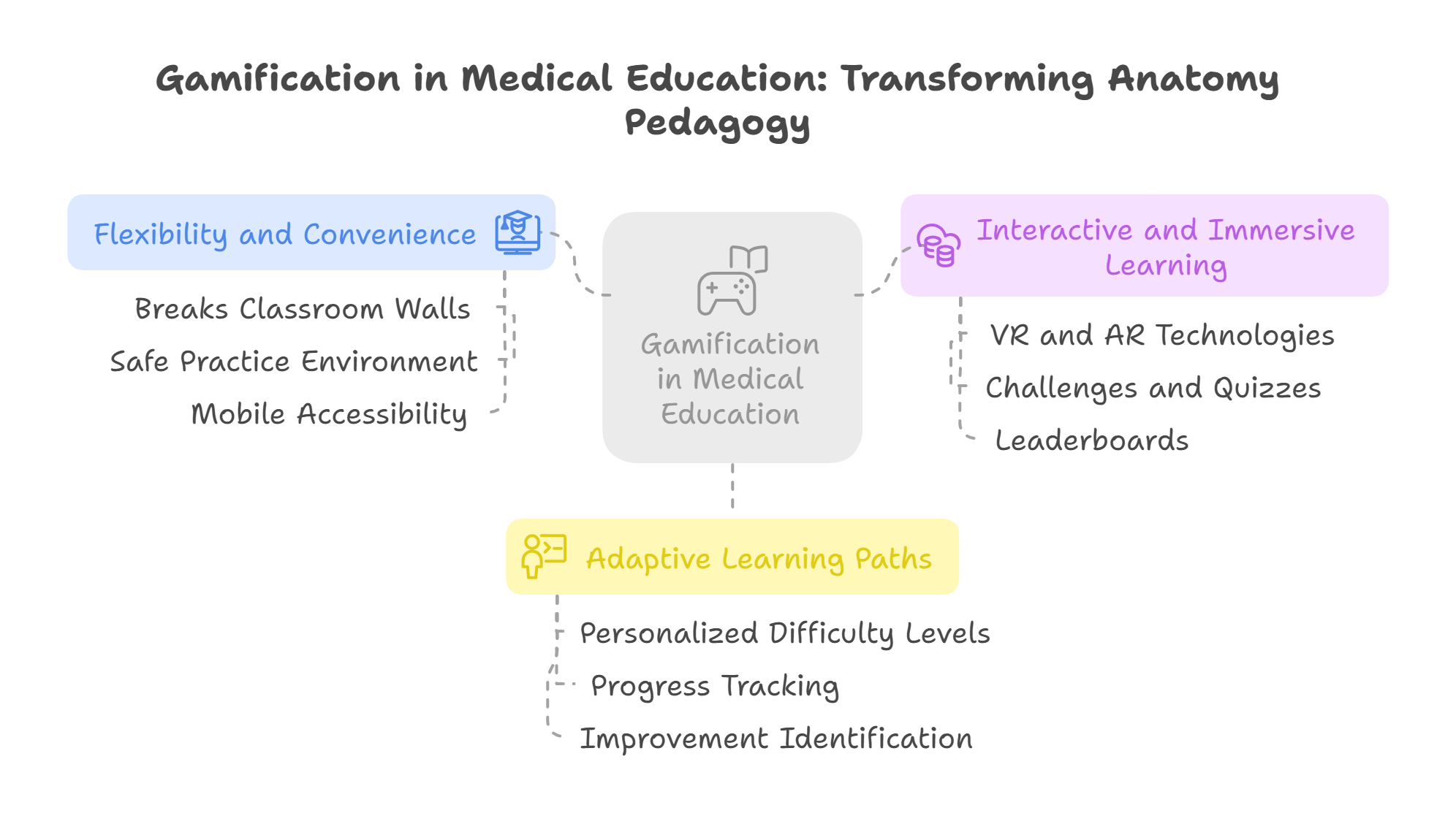
How is Gamification In Medical Education Redefining Anatomy Pedagogy?
The benefits of gamified anatomy education are numerous. Let’s check out some of the major ways in which gamification is transforming the landscape:1. Flexibility and Convenience
Game-based learning breaks the classroom walls and eliminates barriers like distance and availability. This flexibility creates a personalized experience for the students, giving them more control over their learning curve. Moreover, using gamified resources allows students to practice cadaveric dissection skills in a safe environment. As there is no fear of mistakes and failures, games boost learners’ confidence and enable them to make informed decisions. In addition, gamified content leverages easy accessibility to mobile devices, allowing students to mix fun and studies.2. Interactive and Immersive Learning Experience
Traditional textbooks and lectures rely on rote learning. This can be boring, making knowledge retention difficult. Cut to gamified elements such as VR and AR; the students can have hands-on experience. These technologies demonstrate the anatomical structures, making the learning more immersive. The result? Better knowledge retention. For example, a VR-based game in which students can find and identify a particular body part using a virtual dissection tool. Similarly, challenges, quizzes, and leaderboards motivate and engage the students, making learning fun.3. Adaptive Learning Paths
Using gamification in healthcare education redefines the learning journey, allowing students to create a personalized learning path. For instance, an anatomy-based quiz allows learners to select the difficulty level based on their learning journey. This helps them track their progress and identify room for improvement.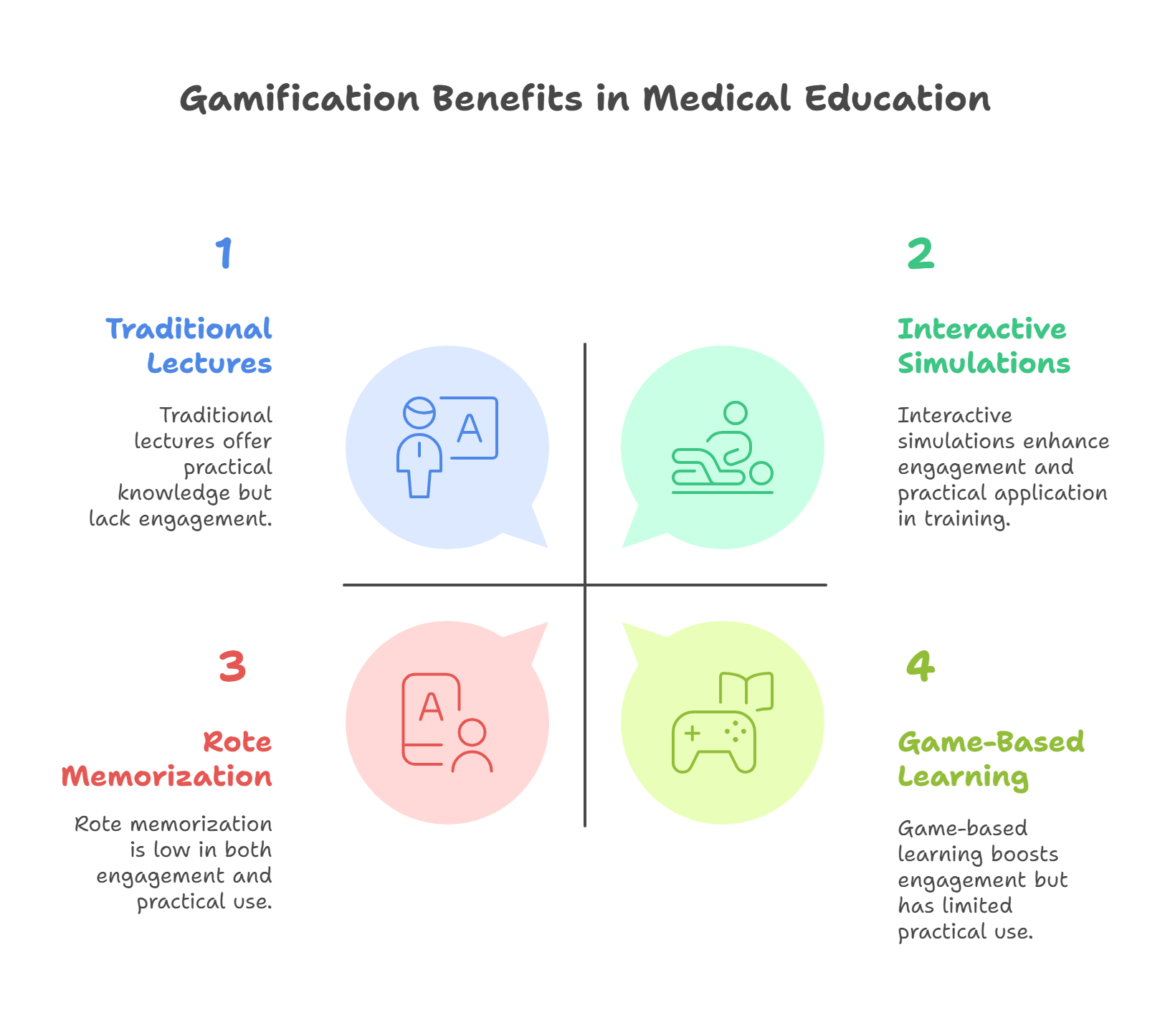
How Does Gamification in Medical Education Make Patient Safety Training More Effective?
Nothing can replace the hands-on experience in patient safety education. Among different training innovations, gamification is perhaps the best suited. Game-based training and interactive scenarios leverage a learner’s innate competitiveness to find more engaging ways to elevate the training program. Here’s how gamification in education adds value to training programs for patient safety:1. Hands-on Practical Training
Let’s face the music: memorizing lengthy theories is super boring. But, thanks to gamification, patient safety education has become a fun activity with immersive technology and interactive sessions. Game-based learning enables the learners to experience complex safety protocols and make critical decisions in a risk-free environment. Unlike conventional rote memorization, practical training is engaging. What’s more, it boosts learners’ confidence to take on real-world challenges in the healthcare industry.2. Inter-Generational Appeal
Each age group has its own strengths and learning curves, and gamification transcends the age barriers. However, employing traditional teaching may not create a uniform and captivating experience. Enter gamification in education! You can create patient safety education programs for learners across different age groups with interactive elements. For example, for Generation X learners, games allow them to progress at their own pace. Similarly, for Millennials who love instant feedback, game-based learning provides that effortlessly.3. Risk-Free Clinical Examples
For years, aspiring healthcare workers had to practice their skills either on cadavers or directly work with real patients. Gamification in education allows practitioners to rehearse and strengthen their skills in a controllable space before actually working with a real patient. It also provides a risk-free environment for healthcare professionals to encounter and learn from clinical examples without jeopardizing patient safety or well-being.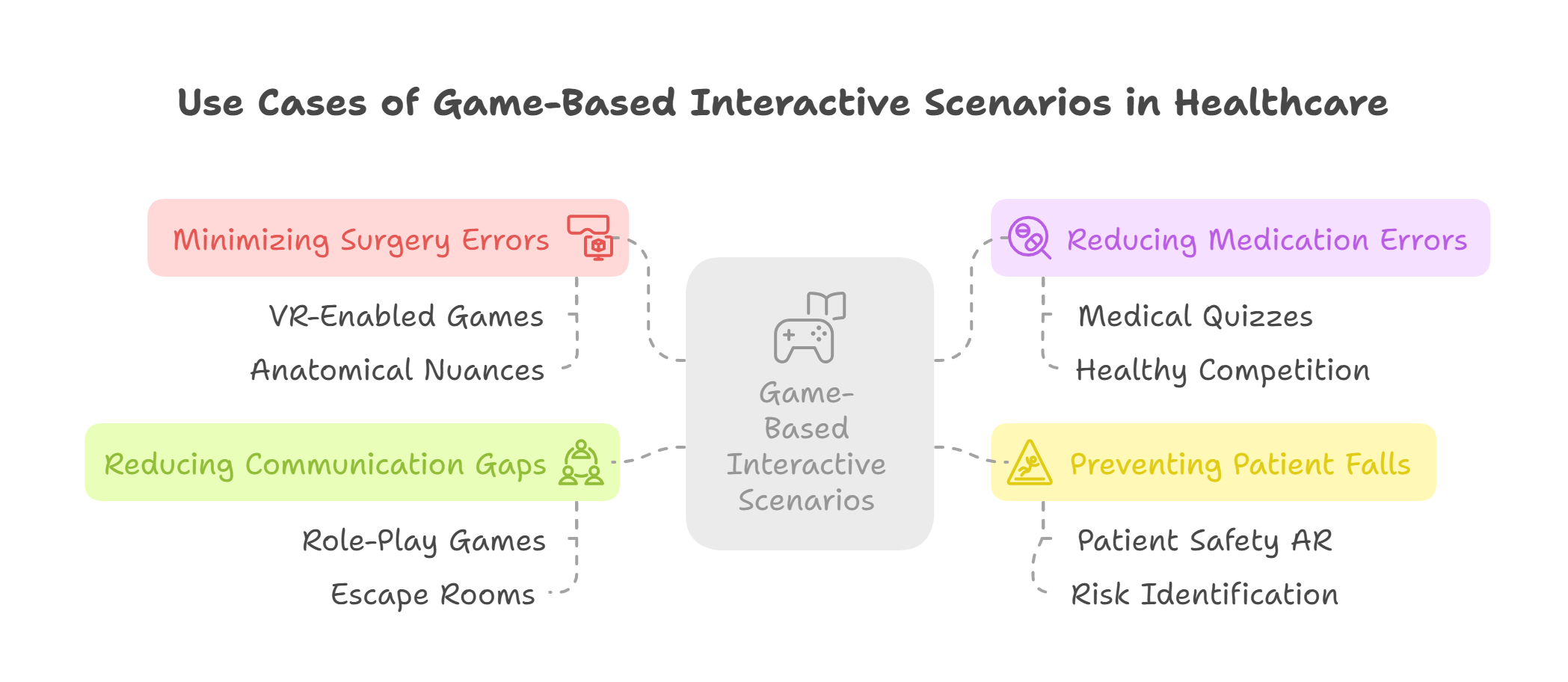
Use Cases of Game-Based Interactive Scenarios
Here’s a snapshot of the various use cases of game-based interactive scenarios in patient safety education:1. Minimizing Surgery Errors: Immersive Games
Surgeries, even the minor ones, are complex. It requires an exceptional degree of precision and concentration. Earlier medical schools used cadavers to let students practice and enhance their skills. However, these methods were not effective in navigating through the complications. VR-enabled surgery games use immersive experiences to explore the anatomical nuances of the human body in 3D. Learners can perceive virtual organs, creating an intriguing learning environment.2. Reducing Medication Errors
According to the World Health Organization (WHO), medication-related errors affect 1 out of every 30 patients, half of which are preventable. Medical students often find it difficult to judge the right amount of medication. The humongous volume of medications and their pharmacological composition can make sifting through them challenging. Medical quizzes are fun ways to test learners’ knowledge about medication. By earning points for every correct answer, such games create healthy competition among peers, encouraging continuous learning and self-assessment.3. Preventing Patient Fall/Injuries: AR-Based Games
Hospital falls range from 3 to 5 per 1000 bed days. These falls result in injuries, including fractures and head trauma, resulting in a financial burden on healthcare systems, While preventing these falls is not always feasible, fast-paced games like Patient Safety AR are designed for healthcare workers. This game promotes identifying risks and taking preventative measures to minimize patient falls.4. Reducing Communication Gaps in Healthcare
Efficient communication is crucial for healthcare workers, especially in complex scenarios. However, making communication channels smooth can be challenging and time-consuming. That’s where gamification comes into the picture. Game-based learning is an effective and enjoyable way to enhance communication skills. For example, role-play games best refine effortless communication among team members. Moreover, gamification in education helps to overcome communication barriers and create a collaborative channel. For example, team-based games like escape rooms encourage better communication among team members.Final Words
With the healthcare education market expected to reach $164.6 by 2028, gamified medical education is poised to redefine the industry. By using the immersive experience of VR technology and Gamification, you can enhance the skills and knowledge of next-generation surgeons, meet the challenges of modern healthcare, and promote collaboration across disciplines. At Hurix Digital, we’re committed to driving this change. With our innovative digital learning solutions, we’re dedicated to leveraging technology to enhance learning experiences, making education more interactive and practical across various industries, including healthcare training. Connect with our team for more info!
Senior Vice President
A Business Development professional with >20 years of experience with strong capability to sell new solutions and develop new markets from scratch. New Market Entry Specialist with experience of working in two of the largest emerging markets – China & India. Also covered other key markets in APAC, US, EU & ME. Exceptional experience of conceptualizing, ideating and selling new learning technologies like VR AR, etc. across multiple industry verticals.




